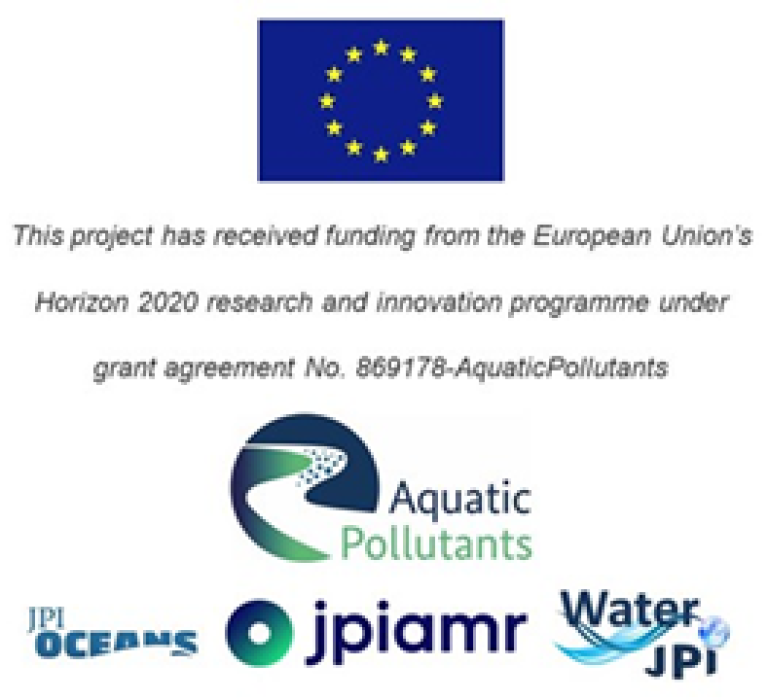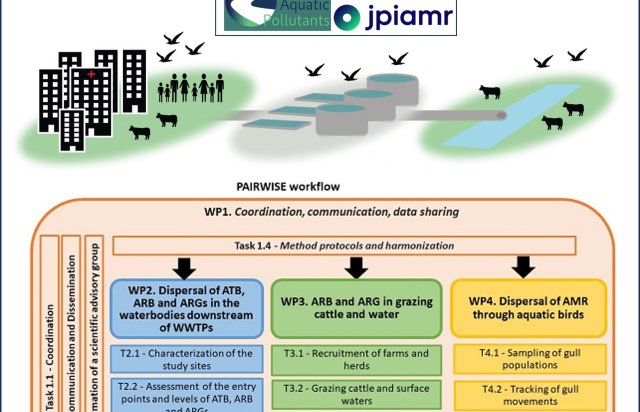PAIRWISE
PAIRWISE aims to advance knowledge of antimicrobial resistance as a pollution in aquatic environments, wildlife, and livestock. PAIRWISE focuses on dispersal and dynamics of antibiotic resistant bacteria, antibiotic resistance genes and antibiotics in aquatic environments affected by wastewater treatment plants.
About the project
PAIRWISE investigates the dispersal of antimicrobial resistance (AMR) and antibiotics in water ecosystems and its influence on livestock and aquatic wildlife. The project is run under and financed by the Joint Programming Initiatives (JPIs) on Water, Oceans and Antimicrobial Resistance (AMR).
The overall goals of PAIRWISE are to understand:
- The dispersal of antibiotic resistant bacteria (ARB), antibiotic resistance genes (ARGs) and antibiotics in surface waters downstream of wastewater treatment plants;
- The carriage of ARB and ARGs in livestock linked to surface waters influenced by wastewater treatment plants;
- The role of aquatic birds in the dispersal of ARB and ARGs.
Issues from the JPI call tackled by PAIRWISE include, but are not limited to
- Entry points and fate of ARB, ARGs and antibiotics;
- Identification of ARGs and ARB useful as indicators;
- Providing insight to fate and transport of ARB, ARGs and antibiotics to, within, and from aquatic ecosystems;
- The role of aquatic birds in such events.
PAIRWISE assesses the influence of AMR in agricultural settings and improves understanding of the dissemination and sustainment of AMR in the interface between humans, wildlife, and livestock with a One Health perspective. It provides vital knowledge for policymakers and end-users, facilitating informed decisions on mitigation strategies.
NIVA leads the work on the dispersal of ARGs, ARB and antibiotics in waters (Work Package 2).
Main tasks include:
- development of the methods protocols and harmonization, characterization of the study sites;
- determining the background levels, abundance and diversity of selected ARGs, ARB and antibiotics in aquatic environments;
- assessment of the entry points and levels; and
- evaluation of impact factors and dispersal of ARGs, ARB and antibiotics considering environmental, geographical, climatic, and temporal dimensions.


More information
Project partners
- Jonas Bonnedahl, Linköping University (LiU)Department of Biomedical and Clinical Sciences, Linköping, Sweden.
- Hanna Woksepp, Region Kalmar County, Department of Research and Linnaeus University Kalmar, Department of Chemistry and Biomedical Sciences, Sweden.
- Stefan Börjesson, School of Health Sciences, Örebro University, Örebro, Sweden
- Karin Persson Waller, National Veterinary Institute (SVA), Department of Animal Health and Antimicrobial Strategies, Uppsala, Sweden
- Maria Rincón Gracia, National Veterinary Institute (SVA), Department of Animal Health and Antimicrobial Strategies, Uppsala, Sweden
- Thomas Rosendal, National Veterinary Institute (SVA), Department of Disease Control and Epidemiology, Uppsala, Sweden
- Robert Söderlund, National Veterinary Institute (SVA), Department of Microbiology, Uppsala, Sweden
- Pawel Krzeminski, Norwegian Institute for Water Research (NIVA), Urban environments and infrastructure, Oslo, Norway
- Carsten Ulrich Schwermer, Norwegian Institute for Water Research (NIVA), Urban environments and infrastructure, Oslo, Norway
- Andy J. Green, Estación Biológica de Doñana, Consejo Superiorde Investigaciones Cientificas (EBD-CSIC), Department of Wetland Ecology, Sevilla, Spain
- Victor Martin, Estación Biológica de Doñana, Consejo Superiorde Investigaciones Cientificas (EBD-CSIC), Department of Wetland Ecology, Sevilla, Spain
- Olfa Mahjoub, National Research Institute for Rural Engineering Water, and Forestry (INRGREF), Department of Chemistry Laboratory for Water-Soil-Sludge.
- Rachida Aouay, National Research Institute for Rural Engineering Water, and Forestry (INRGREF), Department of Chemistry Laboratory for Water-Soil-Sludge.
- Wejdene Mansour, Faculty of medicine Ibn Al-Jazzar Sousse (FMS), Department of Microbiology.
- Yosra Mani, Faculty of medicine Ibn Al-Jazzar Sousse (FMS), Department of Microbiology.
- Aziza Messaoudi, Faculty of medicine Ibn Al-Jazzar Sousse (FMS), Department of Microbiology.
- Charles Masembe, Makerere University, College of Natural Sciences, Department of Entomology and Fisheries Sciences.
- Robinson Odong, Makerere University, College of Natural Sciences, Department of Zoology, Entomology and Fisheries Sciences.
- Peter Akoll, Makerere University, College of Natural Sciences, Department of Zoology, Entomology and Fisheries Sciences.
- Johnson Mayega, Makerere University, College of Natural Sciences, Department of Zoology, Entomology and Fisheries Sciences.
- John Omara, Makerere University, College of Natural Sciences, Department of Biochemistry and Sports Sciences.
Publications (more below)
1. Schwermer, C.U., Krzeminski, P. Dette kan være nøkkelen i kampen mot antibiotikaresistens. Forskersonen 2023. https://forskersonen.no/antibiotika-antibiotikaresistens-kloakk/dette-kan-vaere-nokkelen-i-kampen-mot-antibiotikaresistens/2157487
 Pawel Krzeminski
Pawel Krzeminski
 Carsten Ulrich Schwermer
Carsten Ulrich Schwermer